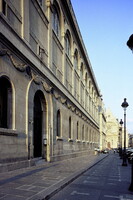Bibliothèque Sainte-Geneviève
Labrouste, Henri

Download1A1-LH-BS-A2_cp.jpg (531.1Kb)
Date
1838-1851Description
Tight vertical view along façade, looking east, depicting entrance; Labrouste finally received his first important public commission: the Bibliothèque Sainte-Geneviève, Place du Panthéon, Paris. He worked for four years (1839-1842) on the design of the building, which was opened in 1851. He conceived the library as a sort of basilica in the Roman manner, with an elongated rectangular plan; the building is also reminiscent of a medieval monastic refectory and it has been compared to the refectory of the 13th-century St Martin-des-Champs, Paris. The main book stacks were placed on the ground-floor, expressed externally as a heavily rusticated base with small openings; above was placed the reading-room, with access via a staircase block projecting from the centre of the long, rear façade. The most striking feature of the Bibliothèque is the structure of the reading-room, where an exposed iron frame was used for the first time in a monumental building. The frame consists of decorated cast-iron arches and piers, with fireproof 'vaults' formed from latticework clad in plaster. Source: Grove Art Online; http://www.groveart.com/ (accessed 12/2/2007)
Type of Work
library (building)Subject
architectural exteriors, Neoclassical, Renaissance Revival
Rights
Rights Statement
Licensed for educational and research use by the MIT community only